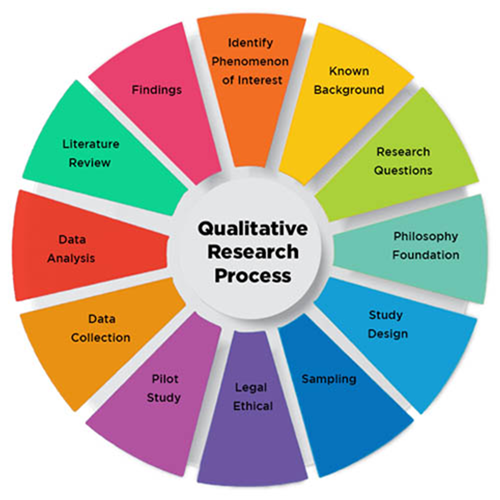Compare and analyze qualitative and quantitative approaches. Give a detailed introduction to the qualitative research process
In-Brief
- Statistical data analysis in qualitative market research tries to preserve the voice and perspective of the respondent and adjusted as new research questions that arise
- Quantitative data analysis in business research can be adapted as new ideas or patterns emerge. They are not rigidly decided beforehand.
- Detailed descriptions of people’s experiences, feelings and perceptions can be used in designing, testing or improving systems or products and the qualitative factors in business decision making.
Introduction
The qualitative research process involves collecting and analyzing non-numerical data, E.g., text, video, or audio to understand concepts, opinions, or the needs of the consumer—the method used to gather in-depth insights problem or to generate new ideas for research.
Sampling design in qualitative research methodology is the most vital step in research. In general terms, qualitative research consists of an investigation of the business product or service by,
- Seeking answers to a particular question
- Systematically using a predefined set of hypothesis to answer the question
- To collect shreds of evidence
- They produce findings that are not determined in before
- Making findings that are useful beyond the boundaries of the research
Additionally, it seeks to understand a given set of research problem in a topic from the perspectives of the local population whom it involves. Qualitative research is used explicitly in obtaining cultural-specific information about the values, opinions, behaviours, and social contexts of target people.
Comparing Quantitative and Qualitative Research
Market research qualitative data analysis have some common primary difference they are,
- Differ by analytical objectives
- Differ by types of questions they choose
- Differs by types of data collection method they use for research
- Differs by the type of data they produce
Comparison of qualitative style and quantitative style
| Quantitative style | Qualitative style |
| Measure objective facts | Construct social reality, cultural meaning |
| Focus on variable | Focus on interactive process events |
| Reliability is a key | Authenticity is the key |
| Independent of context | Situationally constrained |
| Value-free | Value is present and explicit |
| Statistical analysis | Thematic analysis |
| Research is detached | Research is involved |
Comparison of quantitative and qualitative research approaches
| Quantitative approach | Qualitative approach | |
| General framework | Seek to confirm method phenomenaInstruments use a more firm for eliciting and categorizing responses to question framedUse structured type methods such as questionnaires, surveys, and structured observation | Seek to explore various phenomenaInstruments use more flexible, constant style of eliciting and categorizing the responses to questionsIt uses semi-structured methods such as in-depth interviews, that focus groups, and participant observation |
| Analytical objective | To quantify variationTo predict causal relationshipsTo describe characteristics of a population | To describe variationTo define and explain relationshipsTo describe individual experiencesTo describe group norms |
| Question format | Closed-ended | Open-ended |
| Data format | Numerical (obtained by assigning numerical values to responses) | Textual (obtained from audiotapes, videotapes, and field notes) |
| Flexibility in study design | The study design is constant from beginning to endParticipant responses do not affect or determine how and which questions researchers shoot nextThe study design is subject to statistical assumptions and conditions framed | Some aspects of the study are a flexible example, the addition, removal, or wording of specific interview questionsRespondent responses affect how and which questions researchers shoot nextThe study design is ceaseless, that is, data collection and research questions adjusted according to what is framed |
The vital difference between quantitative and qualitative method is their flexibility. However, the qualitative business research and analysis method are relatively inflexible. With the help of quantitative research methods such as survey and questionnaires, researchers tend to ask the participants all the identical question in the order. The major response categories from participants may have a close-ended or fixed format. However, quantitative data analysis tools need a thorough understanding of the essential key questions to ask, the best way to communicate with them, to get the range of possible responses.
The qualitative research process
Identify the phenomenon of interest:
Qualitative data analysis dissertation helps you with the usual approach that includes ground theory, ethnography and narrative research. It has the same set of similarities but has different objective a perspective of the study.
Known ground:
Set a clear goal before you carryout the ground research. Choose a topic that has rich data that is interesting and inductively develop a theory
Research question:
Before framing the research, the question has a clear vision of the target answer you are expecting from the respondent, by keeping this thing in mind frame a practical question.

Philosophy foundation:
After framing the research, the question has a great foundation on the theories that have a broad field of research. The philosophy foundation is effectively carried out by reading various theories and articles related to your research
Study design:
Qualitative Data Analysis Help for dissertation assist you with the study design that is an essential thing in the overall research process. The study design helps in having a good flow of the content logically. It helps to drive the research logically.
Pilot study:
- Action research
Researchers and respondent collectively link theory to drive research change.
- Phenomenological research
Researchers study a phenomenon or case by describing and interpreting participants experiences.
- Narrative research
The researchers examine how stories are delivered to understand how participants perceive and make sense of their research experiences.
Data collection:
Each of the research approaches involves one or more data collection methods.
- Observations: Recordings have seen, heard, or encountered in detailed research notes.
- Interviews: Personally concerning people questions in one-on-one conversations.
- Focus groups: Asking questions and generating results among a group of people.
- Surveys: Shooting questionnaires with open-ended questions.
- Secondary research: Collecting the existing data that is available in the field of study and collecting these data in the form of texts, images, audio or video recordings, etc.
Data analysis:
It is analyzing and intercepting the predefined data. Data analysis is the procedure for analyzing the data to get an outcome.
Findings:
It is the process of presenting the findings of the research in the form of data presentation, data visualization, graph, statistics, figures.
Conclusion
Coding in qualitative research analysis work in the specified field offers unique opportunities for understanding complex research, nuanced situations that are difficult to understand where interpersonal ambiguity and multiple interpretations present. Qualitative research may not provide defined answers to such complex questionnaires, but it can lead to a better understanding of further work.
References
- Austin, Z., & Sutton, J. (2014). Qualitative research: Getting started. The Canadian journal of hospital pharmacy, 67(6), 436.
- Winter, G. (2000). A comparative discussion of the notion of validity in qualitative and quantitative research. The qualitative report, 4(3), 1-14.
- Sargeant, J. (2012). Qualitative research part II: Participants, analysis, and quality assurance.
- Rihoux, B. (2003). Bridging the gap between the qualitative and quantitative worlds? A retrospective and prospective view on qualitative comparative analysis. Field Methods, 15(4), 351-365.

 Previous Post
Previous Post Next Post
Next Post